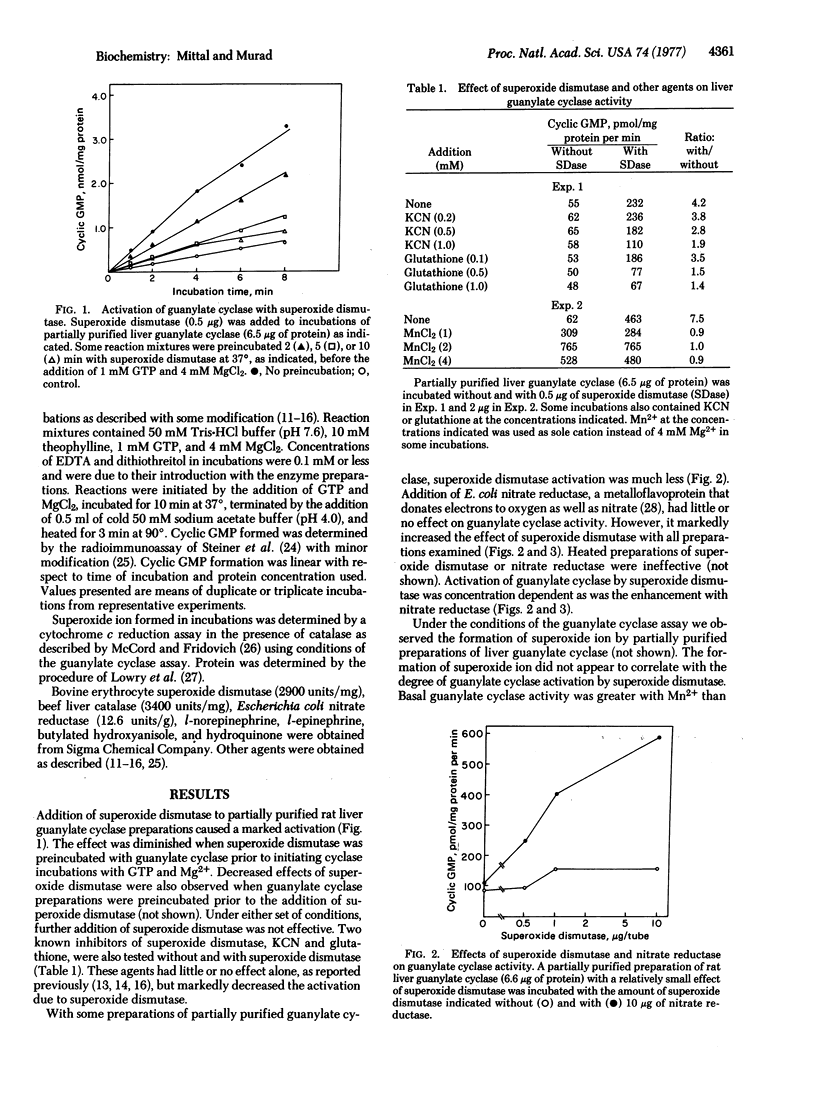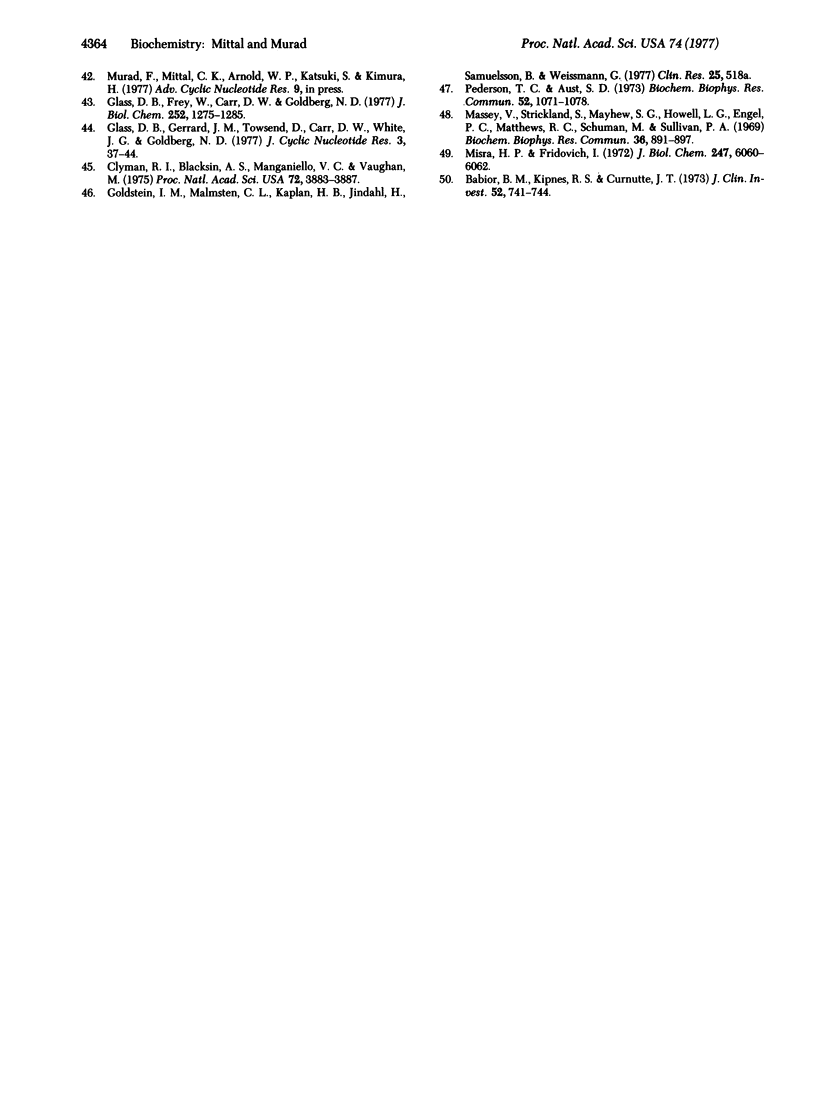Abstract
Partially purified soluble rat liver guanylate cyclase [GTP pyrophosphate-lyase (cyclizing), EC 4.6.1.2] was activated by superoxide dismutase (superoxide: superoxide oxidoreductase, EC 1.15.1.1). This activation was prevented with KCN or glutathione, inhibitors of superoxide dismutase. Guanylate cyclase preparations formed superoxide ion. Activation by superoxide dismutase was further enhanced by the addition of nitrate reductase. Although guanylate cyclase activity was much greater with Mn2+ than with Mg2+ as sole cation cofactor, activation with superoxide dismutase was not observed when Mn2+ was included in incubations. Catalase also decreased the activation induced with superoxide dismutase. Thus, activation required the formation of both superoxide ion and H2O2 in incubations. Activation of guanylate cyclase could not be achieved by the addition of H2O2 alone. Scavengers of hydroxyl radicals prevented the activation. It is proposed that superoxide ion and hydrogen peroxide can lead to the formation of hydroxyl radicals that activate guanylate cyclase. This mechanism of activation can explain numerous observations of altered guanylate cyclase activity and cyclic GMP accumulation in tissues with oxidizing and reducing agents. This mechanism will also permit physiological regulation of guanylate cyclase and cyclic GMP formation when there is altered redox or free radical formation in tissues in response to hormones, other agents, and processes.
Full text
PDF




Selected References
These references are in PubMed. This may not be the complete list of references from this article.
- Arnold W. P., Mittal C. K., Katsuki S., Murad F. Nitric oxide activates guanylate cyclase and increases guanosine 3':5'-cyclic monophosphate levels in various tissue preparations. Proc Natl Acad Sci U S A. 1977 Aug;74(8):3203–3207. doi: 10.1073/pnas.74.8.3203. [DOI] [PMC free article] [PubMed] [Google Scholar]
- Babior B. M., Kipnes R. S., Curnutte J. T. Biological defense mechanisms. The production by leukocytes of superoxide, a potential bactericidal agent. J Clin Invest. 1973 Mar;52(3):741–744. doi: 10.1172/JCI107236. [DOI] [PMC free article] [PubMed] [Google Scholar]
- Chrisman T. D., Garbers D. L., Parks M. A., Hardman J. G. Characterization of particulate and soluble guanylate cyclases from rat lung. J Biol Chem. 1975 Jan 25;250(2):374–381. [PubMed] [Google Scholar]
- Clyman R. I., Blacksin A. S., Manganiello V. C., Vaughan M. Oxygen and cyclic nucleotides in human umbilical artery. Proc Natl Acad Sci U S A. 1975 Oct;72(10):3883–3887. doi: 10.1073/pnas.72.10.3883. [DOI] [PMC free article] [PubMed] [Google Scholar]
- Cohen G., Heikkila R. E. The generation of hydrogen peroxide, superoxide radical, and hydroxyl radical by 6-hydroxydopamine, dialuric acid, and related cytotoxic agents. J Biol Chem. 1974 Apr 25;249(8):2447–2452. [PubMed] [Google Scholar]
- DeRubertis F. R., Craven P. A. Calcium-independent modulation of cyclic GMP and activation of guanylate cyclase by nitrosamines. Science. 1976 Sep 3;193(4256):897–899. doi: 10.1126/science.7837. [DOI] [PubMed] [Google Scholar]
- FEWSON C. A., NICHOLAS D. J. Nitrate reductase from Pseudomonas aeruginosa. Biochim Biophys Acta. 1961 May 13;49:335–349. doi: 10.1016/0006-3002(61)90133-0. [DOI] [PubMed] [Google Scholar]
- Fong K. L., McCay P. B., Poyer J. L., Keele B. B., Misra H. Evidence that peroxidation of lysosomal membranes is initiated by hydroxyl free radicals produced during flavin enzyme activity. J Biol Chem. 1973 Nov 25;248(22):7792–7797. [PubMed] [Google Scholar]
- George W. J., Ignarro L. J., White L. E. Muscarinic stimulation of cardiac guanylate cyclase. Recent Adv Stud Cardiac Struct Metab. 1975;7:381–390. [PubMed] [Google Scholar]
- George W. J., Polson J. B., O'Toole A. G., Goldberg N. D. Elevation of guanosine 3',5'-cyclic phosphate in rat heart after perfusion with acetylcholine. Proc Natl Acad Sci U S A. 1970 Jun;66(2):398–403. doi: 10.1073/pnas.66.2.398. [DOI] [PMC free article] [PubMed] [Google Scholar]
- Glass D. B., Frey W., 2nd, Carr D. W., Goldberg N. D. Stimulation of human platelet guanylate cyclase by fatty acids. J Biol Chem. 1977 Feb 25;252(4):1279–1285. [PubMed] [Google Scholar]
- Glass D. B., Gerrard J. M., Townsend D., Carr D. W., White J. G., Goldberg N. D. The involvement of prostaglandin endoperoxide formation in the elevation of cyclic GMP levels during platelet aggregation. J Cyclic Nucleotide Res. 1977 Feb;3(1):37–44. [PubMed] [Google Scholar]
- Hardman J. G., Sutherland E. W. Guanyl cyclase, an enzyme catalyzing the formation of guanosine 3',5'-monophosphate from guanosine trihosphate. J Biol Chem. 1969 Dec 10;244(23):6363–6370. [PubMed] [Google Scholar]
- Howell S. L., Montague W. Regulation of guanylate cyclase in guinea-pig islets of Langerhans. Biochem J. 1974 Aug;142(2):379–384. doi: 10.1042/bj1420379. [DOI] [PMC free article] [PubMed] [Google Scholar]
- Ichihara K., Larner J., Kimura H., Murad F. Activation of liver guanylate cyclase by bile salts and contaminants in crude secretin and pancreozymin preparations. Biochim Biophys Acta. 1977 Apr 12;481(2):734–740. doi: 10.1016/0005-2744(77)90307-2. [DOI] [PubMed] [Google Scholar]
- KEILIN D., HARTREE E. F. Reactions of methaemoglobin and catalase with peroxides and hydrogen donors. Nature. 1954 Apr 17;173(4407):720–723. doi: 10.1038/173720a0. [DOI] [PubMed] [Google Scholar]
- Katsuki S., Arnold W., Mittal C., Murad F. Stimulation of guanylate cyclase by sodium nitroprusside, nitroglycerin and nitric oxide in various tissue preparations and comparison to the effects of sodium azide and hydroxylamine. J Cyclic Nucleotide Res. 1977 Feb;3(1):23–35. [PubMed] [Google Scholar]
- Kimura H., Mittal C. K., Murad F. Activation of guanylate cyclase from rat liver and other tissues by sodium azide. J Biol Chem. 1975 Oct 25;250(20):8016–8022. [PubMed] [Google Scholar]
- Kimura H., Mittal C. K., Murad F. Appearance of magnesium guanylate cyclase activity in rat liver with sodium azide activation. J Biol Chem. 1976 Dec 25;251(24):7769–7773. [PubMed] [Google Scholar]
- Kimura H., Mittal C. K., Murad F. Increases in cyclic GMP levels in brain and liver with sodium azide an activator of guanylate cyclase. Nature. 1975 Oct 23;257(5528):700–702. doi: 10.1038/257700a0. [DOI] [PubMed] [Google Scholar]
- Kimura H., Murad F. Evidence for two different forms of guanylate cyclase in rat heart. J Biol Chem. 1974 Nov 10;249(21):6910–6916. [PubMed] [Google Scholar]
- Kimura H., Murad F. Nonenzymatic formation of guanosine 3':5'-monophosphate from guanosine triphosphate. J Biol Chem. 1974 Jan 10;249(1):329–331. [PubMed] [Google Scholar]
- Kimura H., Murad F. Subcellular localization of guanylate cyclase. Life Sci. 1975 Sep 15;17(6):837–843. doi: 10.1016/0024-3205(75)90433-6. [DOI] [PubMed] [Google Scholar]
- Kimura H., Murad F. Two forms of guanylate cyclase in mammalian tissues and possible mechanisms for their regulation. Metabolism. 1975 Mar;24(3):439–445. doi: 10.1016/0026-0495(75)90123-7. [DOI] [PubMed] [Google Scholar]
- Kimura H., Thomas E., Murad F. Effects of decapitation, ether and pentobarbital on guanosine 3',5'-phosphate and adenosine 3',5'-phosphate levels in rat tissues. Biochim Biophys Acta. 1974 May 24;343(3):519–528. doi: 10.1016/0304-4165(74)90269-4. [DOI] [PubMed] [Google Scholar]
- LOWRY O. H., ROSEBROUGH N. J., FARR A. L., RANDALL R. J. Protein measurement with the Folin phenol reagent. J Biol Chem. 1951 Nov;193(1):265–275. [PubMed] [Google Scholar]
- Massey V., Strickland S., Mayhew S. G., Howell L. G., Engel P. C., Matthews R. G., Schuman M., Sullivan P. A. The production of superoxide anion radicals in the reaction of reduced flavins and flavoproteins with molecular oxygen. Biochem Biophys Res Commun. 1969 Sep 10;36(6):891–897. doi: 10.1016/0006-291x(69)90287-3. [DOI] [PubMed] [Google Scholar]
- McCord J. M., Fridovich I. Superoxide dismutase. An enzymic function for erythrocuprein (hemocuprein). J Biol Chem. 1969 Nov 25;244(22):6049–6055. [PubMed] [Google Scholar]
- Miki N., Nagano M., Kuriyama K. Catalase activates cerebral granylate cyclase in the presence of sodium azide. Biochem Biophys Res Commun. 1976 Oct 4;72(3):952–959. doi: 10.1016/s0006-291x(76)80224-0. [DOI] [PubMed] [Google Scholar]
- Mittal C. K., Kimura H., Murad F. Purification and properties of a protein required for sodium azide activation of guanylate cyclase. J Biol Chem. 1977 Jun 25;252(12):4384–4390. [PubMed] [Google Scholar]
- Mittal C. K., Kimura H., Murad F. Requirement for a macromolecular factor for sodium azide activation of guanulate cyclase. J Cyclic Nucleotide Res. 1975;1(6):261–269. [PubMed] [Google Scholar]
- Mittal C. K., Murad F. Formation of adenosine 3':5'-monophosphate by preparations of guanylate cyclase from rat liver and other tissues. J Biol Chem. 1977 May 25;252(10):3136–3140. [PubMed] [Google Scholar]
- Pederson T. C., Aust S. D. The role of superoxide and singlet oxygen in lipid peroxidation promoted by xanthine oxidase. Biochem Biophys Res Commun. 1973 Jun 8;52(3):1071–1078. doi: 10.1016/0006-291x(73)91047-4. [DOI] [PubMed] [Google Scholar]
- Rudland P. S., Gospodarowicz D., Seifert W. Activation of guanyl cyclase and intracellular cyclic GMP by fibroblast growth factor. Nature. 1974 Aug 30;250(5469):741-2, 773-4. doi: 10.1038/250741a0. [DOI] [PubMed] [Google Scholar]
- Schultz G., Böhme E., Munske K. Guanyl cyclase. Determination of enzyme activity. Life Sci. 1969 Dec 15;8(24):1323–1332. doi: 10.1016/0024-3205(69)90189-1. [DOI] [PubMed] [Google Scholar]
- Steiner A. L., Parker C. W., Kipnis D. M. Radioimmunoassay for cyclic nucleotides. I. Preparation of antibodies and iodinated cyclic nucleotides. J Biol Chem. 1972 Feb 25;247(4):1106–1113. [PubMed] [Google Scholar]
- THEORELL H., EHRENBERG A. The reaction between catalase, azide and hydrogen peroxide. Arch Biochem Biophys. 1952 Dec;41(2):442–474. [PubMed] [Google Scholar]
- Thompson W. J., Williams R. H., Little S. A. Activation of guanyl cyclase and adenyl cyclase by secretin. Biochim Biophys Acta. 1973 Apr 12;302(2):329–337. doi: 10.1016/0005-2744(73)90161-7. [DOI] [PubMed] [Google Scholar]
- Vesely D. L., Rovere L. E., Levey G. S. Activation of guanylate cyclase by streptozotocin and 1-methyl-1-nitrosourea. Cancer Res. 1977 Jan;37(1):28–31. [PubMed] [Google Scholar]
- Wallach D., Pastan I. Stimulation of guanylate cyclase of fibroblasts by free fatty acids. J Biol Chem. 1976 Sep 25;251(18):5802–5809. [PubMed] [Google Scholar]
- White A. A., Aurbach G. D. Detection of guanyl cyclase in mammalian tissues. Biochim Biophys Acta. 1969;191(3):686–697. doi: 10.1016/0005-2744(69)90362-3. [DOI] [PubMed] [Google Scholar]
- White A. A., Crawford K. M., Patt C. S., Lad P. J. Activation of soluble guanylate cyclase from rat lung by incubation or by hydrogen peroxide. J Biol Chem. 1976 Dec 10;251(23):7304–7312. [PubMed] [Google Scholar]


